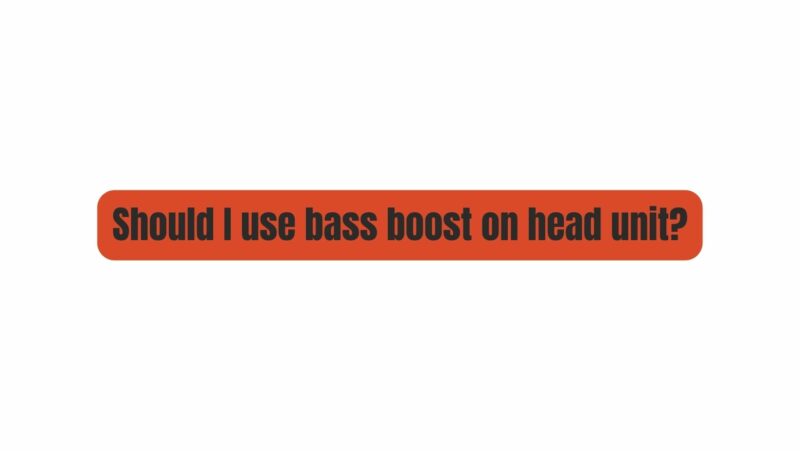In the world of car audio, the quest for the perfect sound system is a never-ending journey. Among the myriad of settings and features available on modern car stereos, one that often catches the attention of audio enthusiasts is the “bass boost” function. This feature, commonly found on head units and amplifiers, promises to enhance the low-frequency response of your car audio system. But should you use bass boost on your head unit? In this article, we’ll dive deep into the world of bass boost, its pros and cons, and the considerations you should keep in mind before cranking up the bass.
Understanding Bass Boost
Before we delve into whether you should use bass boost, it’s essential to grasp what this feature does. Bass boost is essentially an equalization (EQ) function that is designed to increase the level of low-frequency sound reproduction in your car audio system. It achieves this by boosting specific bass frequencies within the audio signal. The result is a more pronounced and powerful bass response, which can be especially appealing to those who enjoy deep, thumping bass in their music.
The Allure of Enhanced Bass
The appeal of bass boost is evident. A robust and thumping bassline can add a visceral and immersive quality to your music, making it more enjoyable for many listeners. It’s not just about feeling the bass; it’s about experiencing the music on a physical level, whether you’re cruising down the highway or parked in your driveway.
Bass boost can also be particularly beneficial for certain genres of music. Electronic dance music (EDM), hip-hop, rap, and other bass-heavy genres often rely on powerful low-end frequencies to create an energetic and engaging sonic experience. In such cases, bass boost can take your audio system to the next level.
The Potential Pitfalls of Bass Boost
While the allure of enhanced bass is undeniable, using bass boost on your head unit or amplifier is not without its drawbacks and potential pitfalls. Here are some considerations to keep in mind:
- Distortion: One of the most significant risks associated with excessive bass boost is distortion. When you crank up the bass too much, it can overwhelm your speakers and amplifier, leading to audible distortion. This distortion not only diminishes audio quality but can also damage your equipment over time.
- Uneven Frequency Response: Bass boost is not a precision tool. It tends to emphasize a narrow range of frequencies, which can lead to an unbalanced sound profile. While you may enjoy the booming bass, other frequency ranges, such as midrange and treble, may be drowned out, resulting in an uneven and less enjoyable listening experience.
- Speaker and Subwoofer Compatibility: The effectiveness of bass boost also depends on the quality and capacity of your speakers and subwoofers. If your speakers can’t handle the increased bass levels, they may produce muddy or distorted sound. This underscores the importance of matching your audio components to achieve optimal performance.
- Listening Environment: The impact of bass boost can vary depending on your listening environment. What sounds great in one setting may not be suitable for another. For example, using bass boost in a small, confined space like a car interior can lead to excessive bass resonance and a less pleasant listening experience.
When to Use Bass Boost
Now that we’ve explored the potential drawbacks of bass boost, let’s discuss when it might be appropriate to use this feature:
- Music Genre: If you primarily listen to genres that heavily rely on bass, such as EDM or hip-hop, using a moderate amount of bass boost can enhance your listening experience. Just be cautious not to overdo it.
- Speaker and Subwoofer Quality: High-quality speakers and subwoofers are better equipped to handle increased bass levels without distortion. If you have premium audio components, you may be able to enjoy bass boost without compromising audio quality.
- Listening Environment: In some situations, like in a car with limited acoustic space, a small amount of bass boost can compensate for the natural loss of low frequencies due to the cabin’s size and shape. Experimentation may be necessary to find the right balance.
- Personal Preference: Ultimately, the decision to use bass boost should align with your personal taste in music and sound. If you love that extra kick of bass and it enhances your enjoyment of your favorite tracks, then by all means, use it in moderation.
The Importance of Balance
Perhaps the most crucial factor to consider when contemplating the use of bass boost is balance. Balance in audio is the key to a satisfying listening experience. Rather than cranking up the bass boost to the maximum, aim for a subtle and controlled boost that complements your music rather than overpowering it.
Furthermore, it’s essential to use your ears as your guide. Listen critically to your audio system with and without bass boost engaged. Make adjustments until you find a setting that retains the overall balance of the music while adding the desired level of low-end punch.
Conclusion: A Tool, Not a Crutch
In the world of car audio, bass boost is a tool that, when used judiciously, can enhance your listening pleasure. However, it’s crucial to approach it with caution and an understanding of its potential drawbacks. Bass boost should complement your audio experience, not dominate it. By carefully balancing your audio settings and considering the genre of music you enjoy, your listening environment, and the quality of your audio components, you can harness the power of bass boost to create an audio system that truly resonates with your musical tastes. Remember, it’s all about finding the sweet spot where the low-end frequencies enhance your enjoyment without overshadowing the rest of the music.


